It’s like Rampart, but mobile game-ish.
Type: Single-player
Genre: Action, Arcade, RTS
Developer: Element Games, LLC
Publisher: Element Games, LLC
Release date: 20 Feb, 2020


Intro
Rampart was one of those games I remember playing as a child, renting it from Blockbuster to play on the Super Nintendo. I remember I was either very good at it, or it wasn’t a very difficult game, because it was one of the few games I could play as a rental when I was young and still beat. Looking at how this game is clearly a “homage to” Rampart, I cynically suspected that I’d pick it up and say “yeah, it’s Rampart” and would otherwise have little to comment upon.
What Is Rampart?
So for all you whippersnappers to whom I’ve totally dated myself, shut yer gobs, gather ’round, and I’ll tell ye a tale of the rose-tinted glory days of the Super Nintendo.
Way back in 1990, Rampart was an Atari arcade game. It was later ported to basically every computer or console that existed at the time, from the Sega Genesis/Mega Drive to the Commodore 64. There was even a Game Boy version. I only played the SNES version, however, so that’s what the rest of this section will talk about.
Rampart is considered a precursor to tower defense games. You play on one of two opposing islands, and build walls around a keep to claim it. During the firing phase, you place cannons, and shoot at your opponent’s walls and cannons (or ships or sea serpents if playing single-player). During the rebuilding phase, you must place Tetris-like pieces to fully enclose at least one keep with walls (including diagonals) or you will be eliminated from the game. Enclosing more than one keep at a time gets you extra cannons to place during the cannon-placement round. Cannons take up 2×2 tiles, and so do keeps.
One of the main challenges is that wall pieces cannot be placed unless there is room for the whole piece, and they are oddly shaped to make trouble for you. You’re on an island, so space is limited, and there are additionally obstacles that do not count as walls for enclosing your keeps. Worse, your own cannons get in the way! There’s some element of strategy in not placing cannons if you might need the space to place extra walls later.
A further strategic element is that your cannons cannot fire again until their last cannonball landed. Building closer to the enemy means your attacks are faster (and more accurate against moving ships), but more vulnerable to invading “grunt” land forces and return fire.
Another key part of the strategy is that while destroyed walls just leave clear space, destroyed cannons continue to be obstacles that block placing walls. In single player, some more dangerous enemy types can leave fires or rubble when they destroy walls that can also never be cleared, and must have walls built around them.
How Is Sky Cannoneer Different?
Well, first off, it’s single-player only. (At least, as of writing this. The developer may expand later.)
The second most glaring thing I notice right away is that you can’t destroy cannons anymore. I mean, that was always my strategy in multiplayer, although I guess it was an effective enough strategy that they wanted to cut it off. Destroying cannons creates an “arms race” situation, where even if you only have one cannon left while the opponent has no cannons left, and you both get new cannons next round, your number of enclosed keeps being equal, that means you have one extra cannon to blast all their cannons away next time. Because destroyed cannons are also obstacles, it’s an “unstable equilibrium” which helps mean that a winner starts to emerge within one or two rounds and once someone is behind, it’s going to snowball into a defeat quickly. The way Sky Cannoneer plays out, you can be ahead all game, then have one unlucky situation where you can’t complete a wall, and lose. Maybe that increases the “party game” unpredictability, but if this is an all-single-player game, a less-skilled player coming from behind is usually just the AI forcing you to restart a level because of bad luck, and that’s annoying, not thrilling.
Third, the game is on sky islands instead of normal sea islands, and there are no longer grunts that get in the way of rebuilding. Instead of needing walls to protect your keeps, you need them to extend a “power grid”. I suppose this is primarily to excuse the fact that the island is mobile, which is necessary to make you always play on the same island.
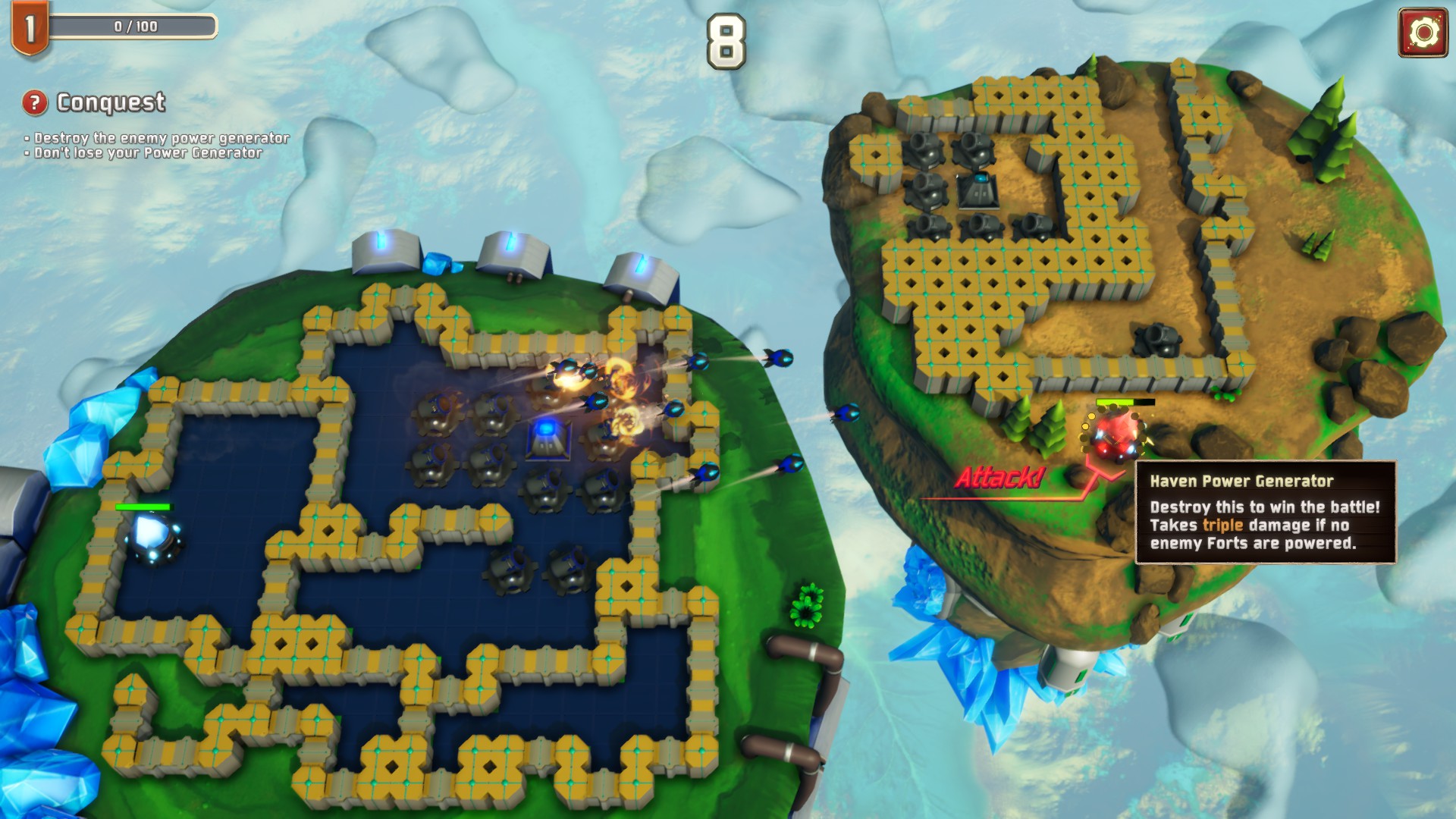
This leads to the fourth, which is that while there are different game modes (or rather mission objectives, as there’s only one game mode) that change the objective of a mission, most are “protect your generator” missions, which make the game slightly more tower defense-like. The generator doesn’t need to be on the power grid, but at least one keep does, or your generator is vulnerable to shots. (It says it takes triple damage, but it feels like a lot more. Otherwise, it’s easier to just shoot the generator without bothering with the walls.) I suppose the theory is that it prevents early-game knockouts, since it’s nearly impossible to destroy a generator in the first two rounds even if the opponent fails to enclose a keep in the first rebuilding round, but in practice, it creates a problem of a lot of unnecessary waiting, which I’ll detail below.
Finally, this game feels like all of the influences that aren’t directly carried over from the original Rampart all come directly from modern mobile games. (Specifically, Clash of Clans seems like a prime contender for influence.) The graphics look like mobile game graphics, levels have up to three stars that you need to collect for resources for upgrades, there are upgrades that even have a waiting bar on them. There are three save slots, but you don’t get to name any of them, they’re just “Profile 1” through “Profile 3”. There aren’t any loot boxes, thankfully, but whether this aesthetic works for you is a matter of taste.
The Story
It exists.
Okay, okay, fine, I’ll take it seriously. Still, this was an arcade game, it doesn’t really need a plot, and it can largely be ignored. The story consists of about half a dozen spoken lines before starting or after completing a mission for the first time. Any that don’t advance the plot just have comic relief one-liners.
The story follows the adventures of (actually, I didn’t get her rank) Officer Rain, leader lady. The writers apparently couldn’t decide whether she was a stoic straight (wo)man type or a Disney-style wisecracking anti-hero-lite, so she’s a little inconsistent.
She is supported by comic relief man Fen. His nominal role is such a formality, it wasn’t until about mission 12 or so that I found out he’s supposed to be the gunner. Gunning is what you’re doing half of the time, so I guess Rain only does the rebuilding. He spends the first third of the game complaining they don’t have battlestations or wanting dragons and the later parts being totally oblivious to the thunderingly obvious plot twists.
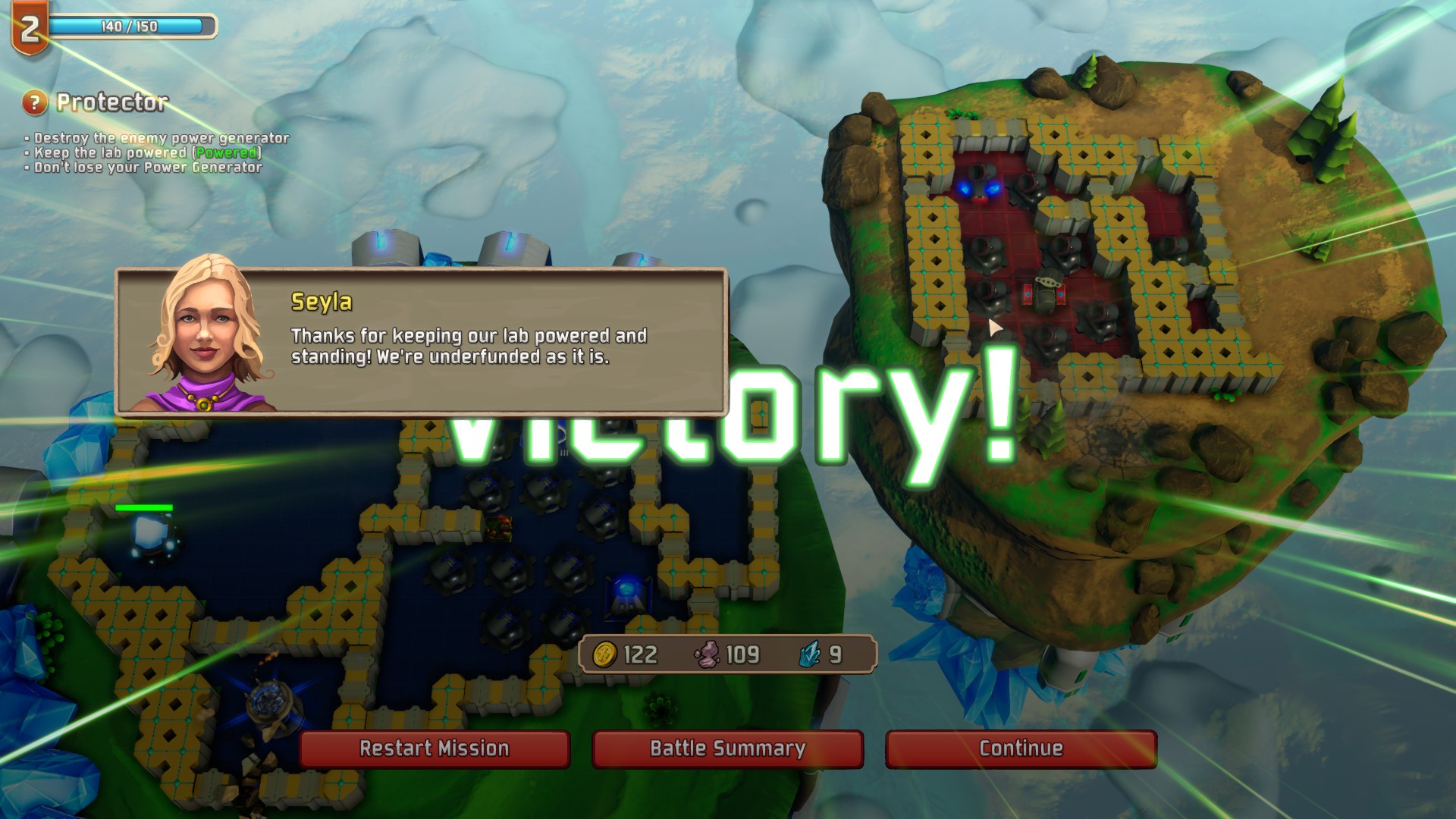
Rounding out the power trio is technobabble lady Seyla. She exists to exposit paper-thin excuses for why one mission has a doohickey you need to keep in the power grid instead of a generator or why there are limited walls for one mission. Also, she dumps exposition on the technology that is apparently entirely based on glowy rocks and something called “vitreon”. Whether vitreon is a type of glowy rock or not is unclear and probably unimportant.
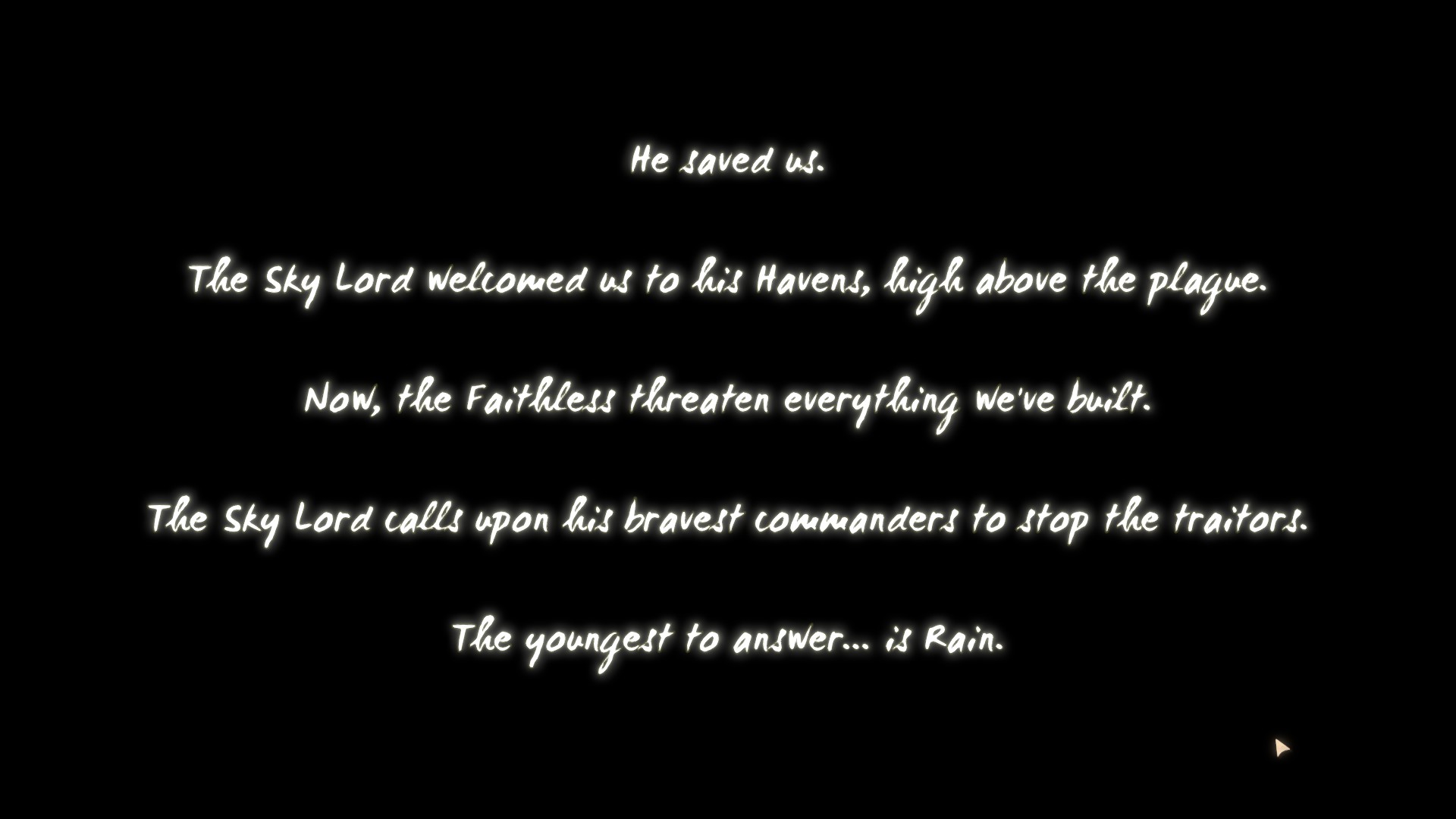
The intro cutscene says there was a disaster, and the Sky Lord saved everyone. How, exactly, is unclear, because sky islands and airships are what keeps people safe and these seem to have existed before the Sky Lord, but that’s not important. What matters is that there are rebels that hate the Sky Lord and want to destroy anyone who supports him. Plus anyone who doesn’t support him. It becomes clear fairly early on the Sky Lord didn’t save everyone, but the rebels are psychopaths that fight you and everyone even if they don’t support the Sky Lord so you can keep shooting them without moral implications.
(Okay, so maybe that wasn’t “taking it seriously”, but really, this is enough of an excuse plot that snark is the only thing that keeps it interesting at all, which is probably why that’s what the characters themselves are doing half the time.)
Only Island
I believe that, even if the developer would for some reason feel it takes some plot contrivance to excuse, a major weakness in this game is that you are stuck on the same island. (At least, as of writing this, I haven’t seen an ability to play on any other island. Maybe it will be added later.) I feel this seriously limits the options that the game has for adding variations in the gameplay, as I found myself always reflexively choosing the same fort to start every mission, and generally using the same upgrades for specific mission types, at that.
In Rampart, different missions could be played out on large, open islands, or narrow islands. Because a key part of strategy was leaving yourself room to repair any hole (which often required building slightly outwards to patch over holes too small to fit normal tiles into), narrow spaces or areas with many obstacles would require more conservative placement. In stages like the sea serpent stage, where it created obstacles when it destroyed walls, abandoning keeps and encircling a new keep even though it meant abandoning your cannons was the only way to survive more than a turn or two of barrage. (That was an “outlast the boss” stage.) It felt genuinely different.
In Sky Cannoneers, every stage feels similar since you are building inside the same island, so your rebuilding strategy is always the same. Worse, although there is variance in the enemy islands, they repeat those, as well, and dragons are basically all palette swaps of one another.
Upgrades
Probably the biggest change to the Rampart formula, there are multiple currencies to collect, upgrades to spend them on, and sub-goals in missions to give more resources.
There are three forms of currency besides experience points for your… um… island level? I’m not sure what, exactly, gains levels, here.
Coins are gained every time you complete a stage, even if you completed it before. This is dubious, because it basically just demands grinding if you are short on coins but have other resources. Fortunately, only a couple unlocks required coins in quantities significant enough that they overshadowed the other currencies, and I didn’t have to stop just to go grinding, but I’m not sure I would stick with this game if I came to a point where I had to just sit there replaying the same maps just to increment a meter.
Metals are kind of interesting in that they randomly might appear outside your walls when a wall is destroyed. It’s always further out than the wall that was destroyed, and you can only collect it by building walls around the metals to put it on your power grid. This encourages aggressive expansion that may hurt your long-term survivability. This kind of conflict of goals creates interesting tension in the game. Sadly, I never was in a position where I needed more metals, so I probably needn’t have bothered, though.
Crystals are gained only by completing star objectives. They are by far the biggest impediment to your upgrades, which is just as well as they are the ones that take serious effort to obtain.
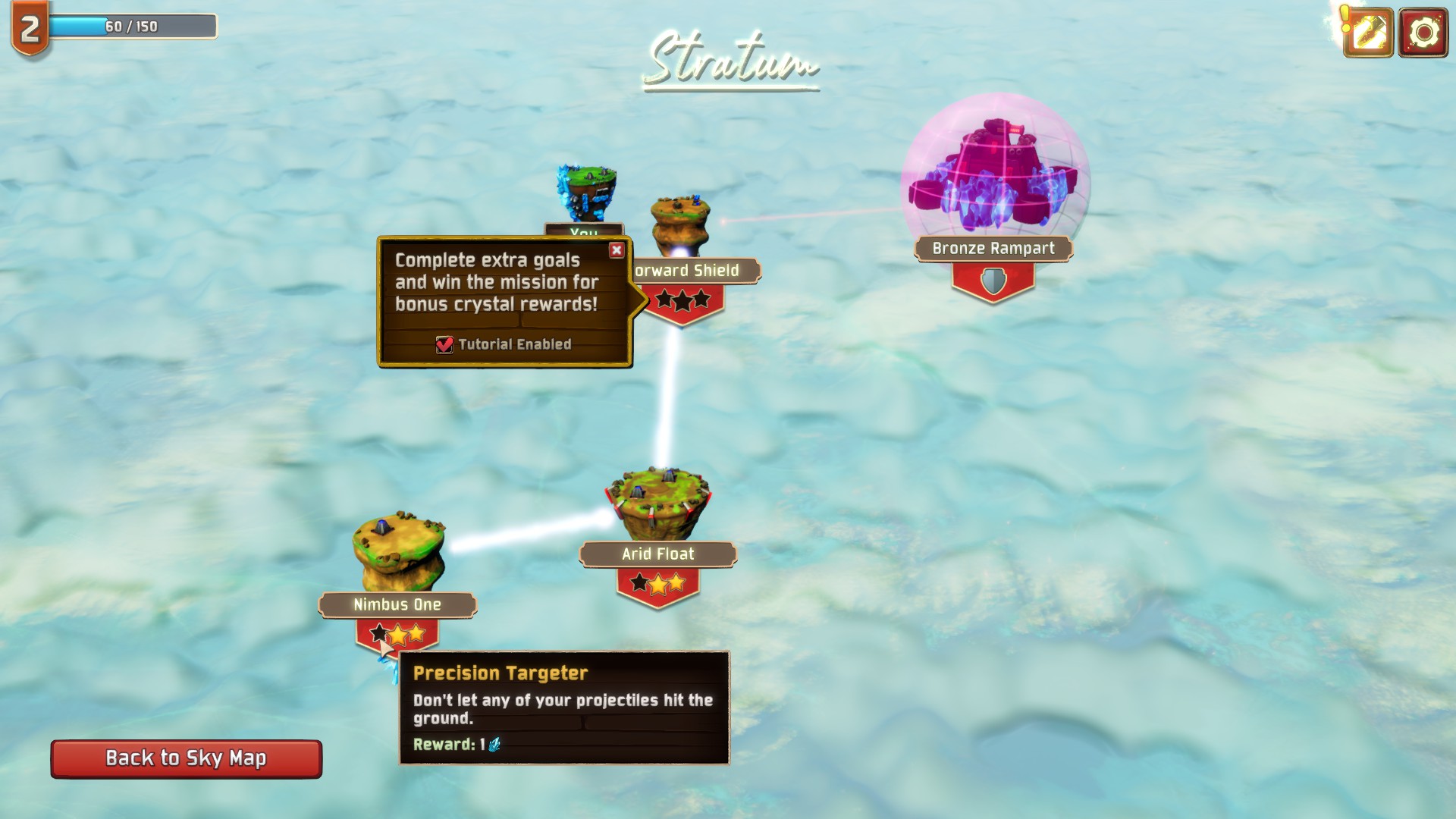
There are three stars for every mission. Getting stars for the first time is the only way to get crystals. One star and one crystal is awarded just for winning a stage, but two other objectives exist and some stars give more than one crystal. Many of these side objectives depend upon having a specific upgrade, already.
Some require you build voltaic forts, for example, but if you haven’t unlocked voltaic forts, it costs 4 crystals and you get 1 crystal for completing that objective…
Others require some degree of strategy or restraint. Needing to build 20 cannons means holding off on winning until you can build all those cannons.
Others underline some problems with the game. I didn’t notice that even though the game will highlight a wall when you mouse over it, the cannons might still miss that wall tile until I failed the “never let a shot hit the ground” star three times.
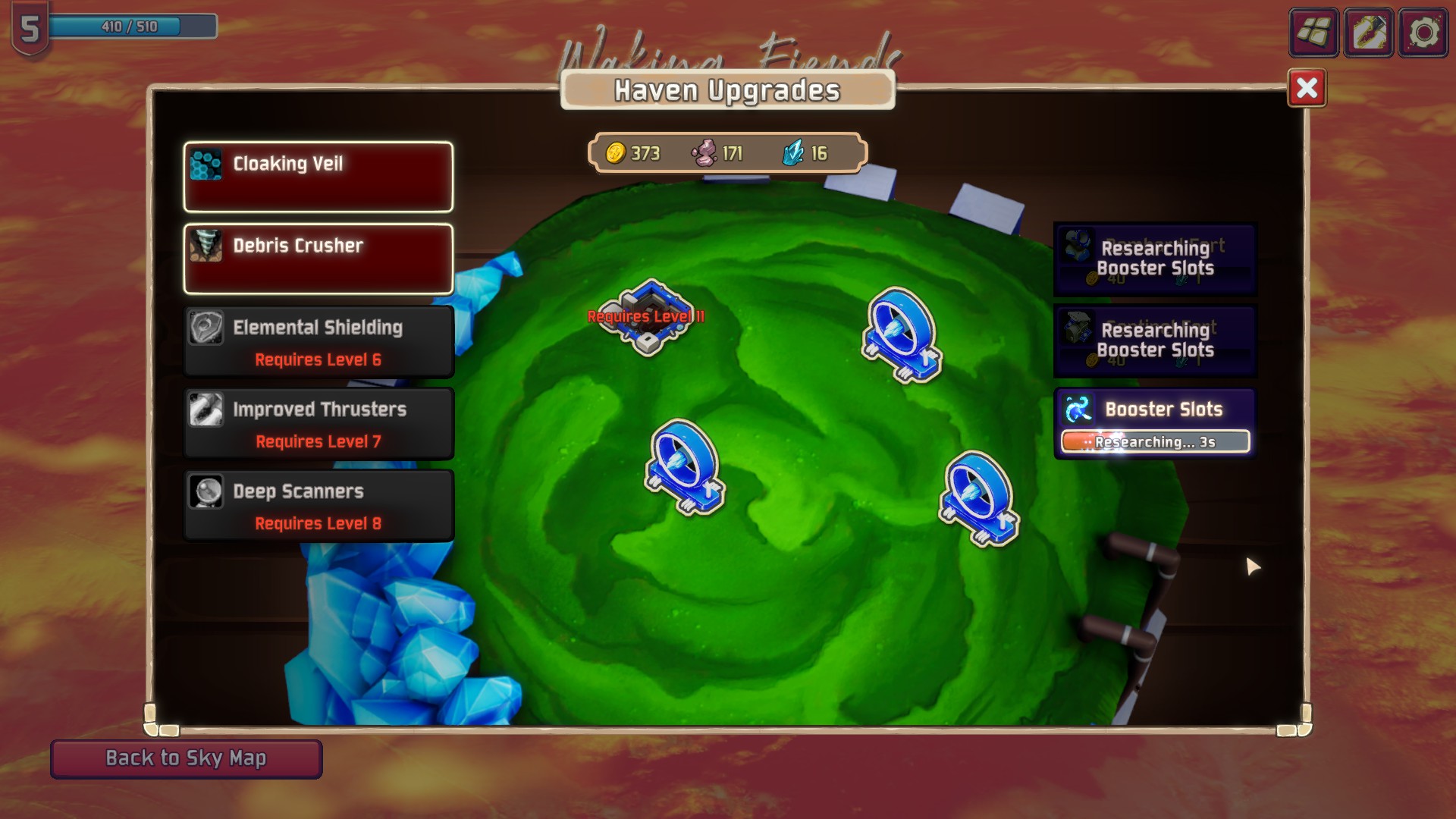
The upgrades are by far what make me the most uneasy. Even after you pay the resource costs that imply grinding, there’s a wait bar on them to be “researched”. Yeah, it’s only three seconds, but why is it there at all if this game isn’t going to be sold as a mobile port at some point where it’s going to take far longer? Everything else about this game’s aesthetics scream “mobile game”, so I have little doubt that’s the route this game is going.
In any event, you need to buy four forts and three boosters, plus options for what the forts or boosters can be. There are multiple choices for your forts, but balance issues rear their head here. One fort is a cannon so you basically get one more cannon… but another fort makes your cannons reload 30% faster. Even in the first round, the reload fort lets your three cannons fire one extra time (for three extra shots), but the cannon fort is just one more cannon (for three shots per firing round). In subsequent rounds, the reloading fort gives you more shots for every cannon you add, but the cannon fort is still just one more cannon at the base speed. The reloading fort is just objectively better. The other early option is a defensive fort, but that’s only as useful as defense is, and this is a game where offense is the best defense.
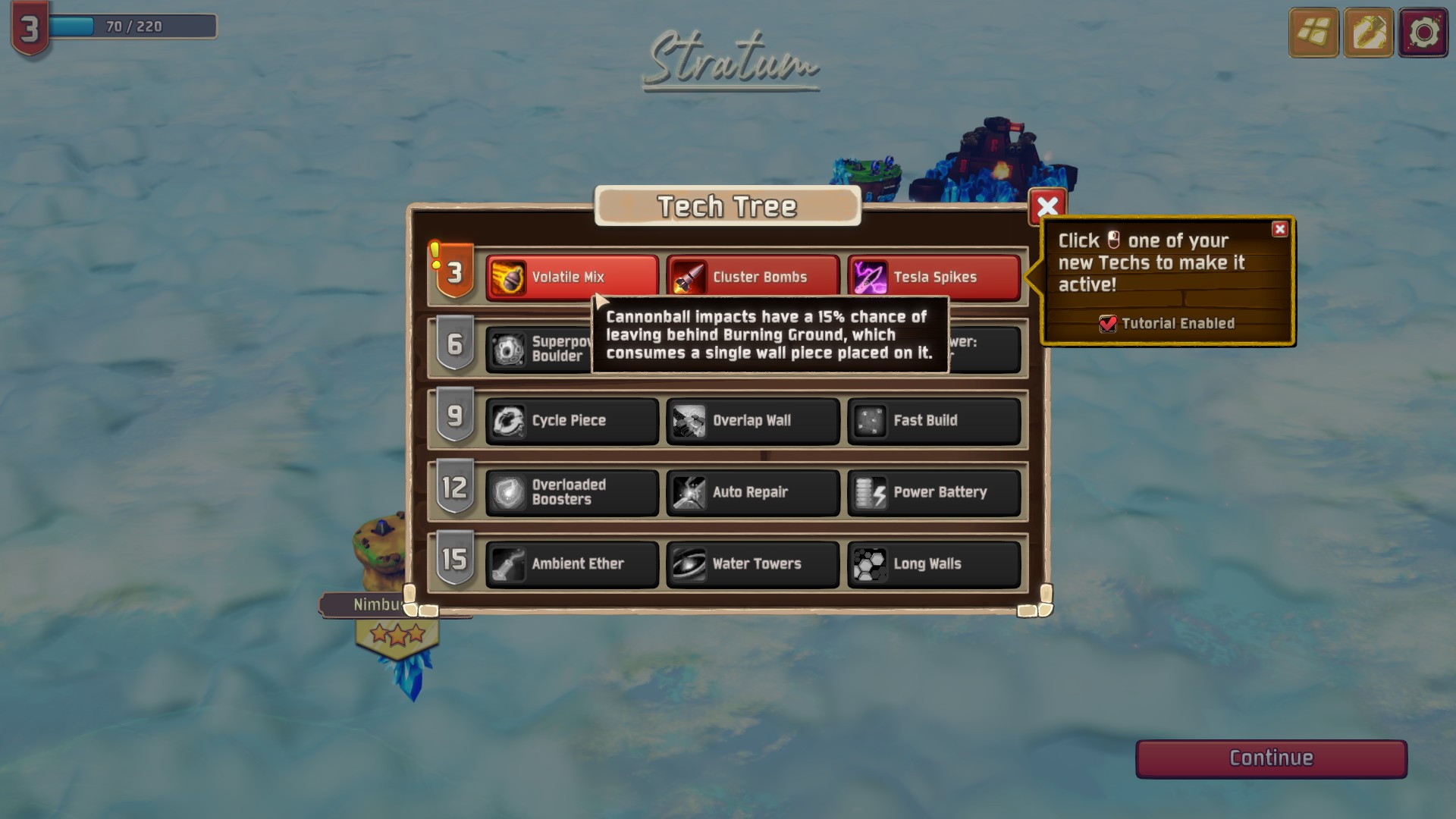
For every three levels, you also get “tech tree” powers, with one choice of three powers at every tier. These range from useless to game-breaking.
Incendiary shells are exceptionally powerful against enemy forts because they block the opponent from rebuilding walls, which dramatically increases your chances of preventing them from enclosing a fort, and therefore winning. Incendiary shells are useless against flying enemies like dragons, however, so you might as well pick the splitting shells that are the only ones that actually do anything at all against dragons. Tesla shells are useless all the time because they are only good for temporarily blocking the enemy from firing instead of destroying the enemy during the firing phase and you’ll never win without going on the offense on the offensive phase.
The second tier involves “superpowers” that you right-click to use. You start with one use per round, but some island upgrades give you more. Fire tornadoes are potent against forts because they inflict more fires that block rebuilding, but they don’t work on flying enemies. Another superpower is a shield to block most attacks, but it only lasts for half a second. Since fire tornadoes don’t work on dragons, take shields against them. Boulders are only good for getting a few star objectives because they’re basically inferior tornadoes that don’t start fires.
The third tier offers you your choice of abilities during the rebuilding phase that directly cripple the only difficulty and strategy the game has. Enclosing forts is easy early on, and only getting to a point where you have so many cannons and walls placed that you have nowhere to place large pieces when you need a small corner piece to plug a hole is a threat to you, so they offer you a power that lets you cycle through wall pieces until you get the one you want, basically making you invincible. If that’s too useful only in the later rounds and you want to win early, another power lets you place walls even when they don’t entirely fit (although at least half the wall tiles have to fit, so it isn’t completely foolproof). This lets you place pieces blindly and aggressively to enclose faster. The last option is taking away the minor delay between pieces… but not being able to place pieces in a blind enough panic isn’t your problem, not being able to fit the pieces you have is your problem, so this power doesn’t do anything to actually help you, and is therefore useless.
The last two tiers are much less notable. The fourth tier is only good for empowered boosters to upgrade your damage and kill the generators or dragons faster because the other options, like having an ONLY TEN PERCENT chance for a wall to auto-repair is so trivial and unreliable it’s not worth considering, and power battery presumes you want to store superpowers.
The last tier has Long Walls, which is the opposite of what you want since you increasingly need smaller wall pieces to survive long-term; Water Towers, which is only effective as a defense against fire attacks; and Ambient Ether for when the opponent doesn’t have fire attacks, and you might as well charge your summon.
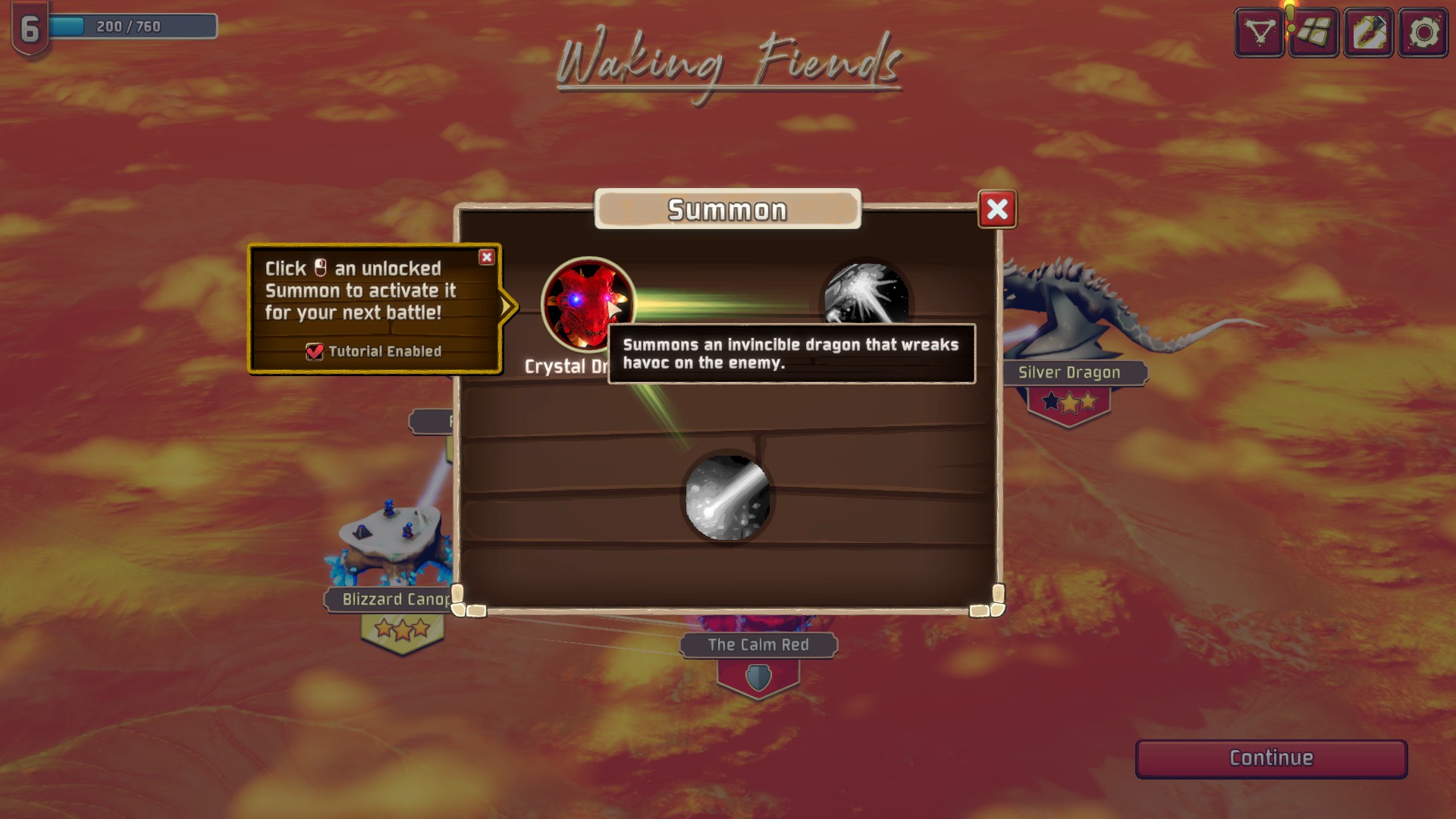
Summons exist. They charge up when you have enough pieces of wall destroyed, so I go through most missions without ever charging them fully and often forget I even have them. The dragon summon deals lots of damage and sets fires but only sticks around for a second. The other summons have health bars and last until destroyed, but do much less damage, with the airship flotilla in particular being so trivial as to not be worth note.
The Impact of Upgrades
On a more meta-gaming level, Rampart had no upgrade system because it was a quick-paced arcade game you were meant to play in bursts and could afford to be short. Even the ports, which changed some features like adding a few alternate powers, still kept the game without any serious “unlocks”. This meant that every player had the exact same powers on any map.
“Unlocks” mean that players of Sky Cannoneers can have wildly different abilities on different maps, and as I mentioned before, some of these upgrades are game-breakingly powerful. Even without the “you basically cannot lose” third-tier “tech tree” upgrades, just having four forts or certain booster unlocks drastically alter how difficult a stage is. By definition, it is harder to balance a game where players may not have enough crystals for all the upgrades, so a collect-them-all player like myself is going to have a much easier time of the game than someone rushing through.
Unlocks are likely here primarily for the purpose of padding out the game’s longevity by making players replay old missions to get all the stars that required upgrades they didn’t qualify for at first, or to make players grind coins, but they also have a knock-on effect on the game’s difficulty. In effect, these unlocks basically make the game harder for less skilled players who need the help, and make the game easier for more skilled players who need more of a challenge. That’s kind of the opposite of what you want in your game design.
I don’t want to sound like a grognard that thinks any change in a new version is inherently bad, but similar to there being generators, I feel this is just a “mobile game element” added just because it’s something mobile games do, not because it makes the game more enjoyable to play.
AI and Difficulty
For reasons I will discuss later, I didn’t manage to finish the game, but what I could play felt unchallenging, or at least, I only occasionally had problems from bad random pieces. It was my mistake not to leave more room in case of bad random pieces, but the game never punished my mistakes enough to make me stop making those mistakes.
Much of the time, battles wind up looking like this, if they can go on for more than 3-5 rounds:
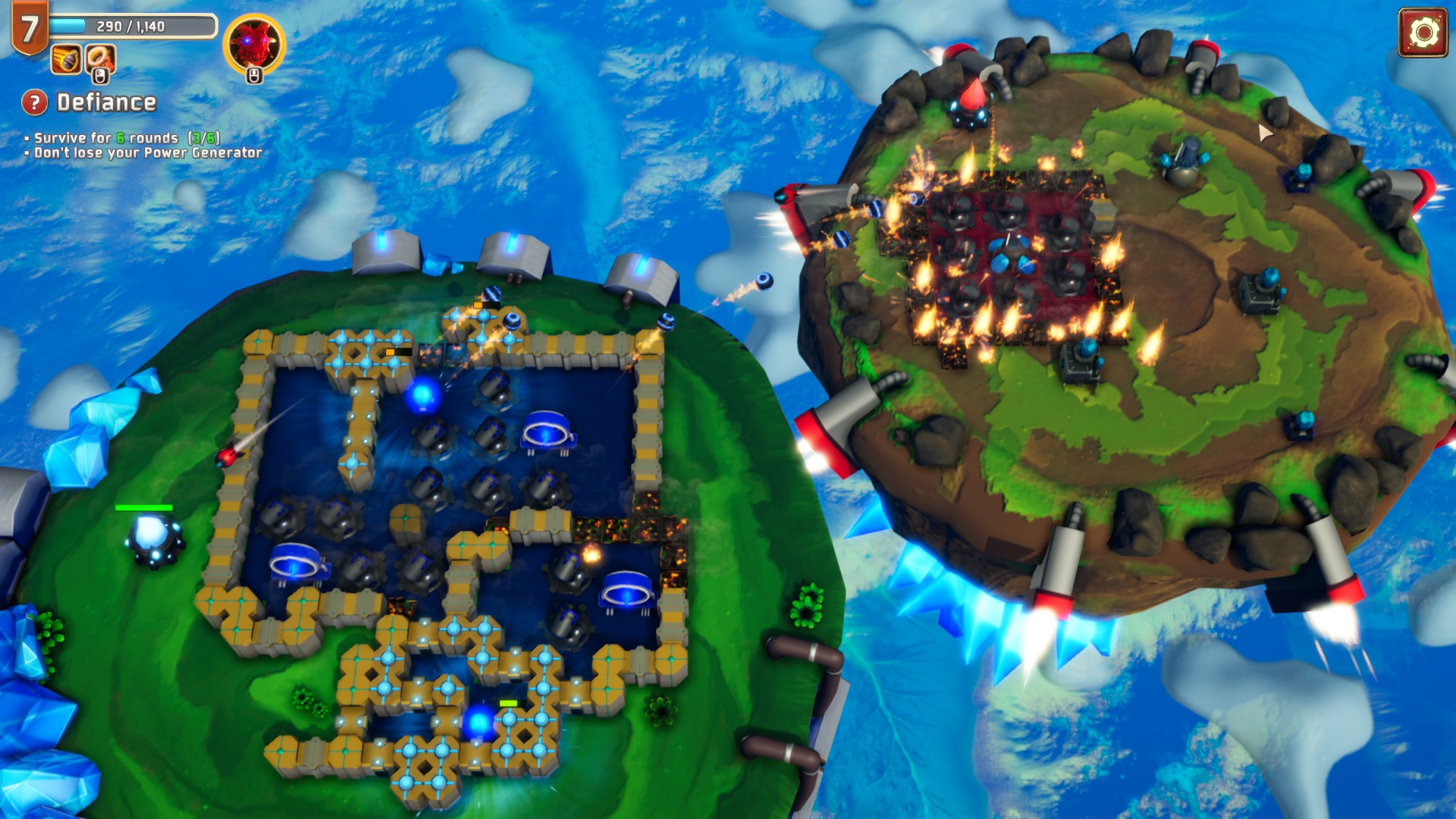
I get an early lead in forts, build more cannons, and prevent the opponent from gaining much ground. I wind up potentially wiping out every single tile of wall they possess at some points, just from lack of any other targets.
This is obviously more noticeable early in the game, when the AI script is bad on purpose to make early stages easy. The AI opponent will deliberately pause a second or so between placing any walls, and they seem to want to build “thick” walls even though it is a bad strategy (see below).
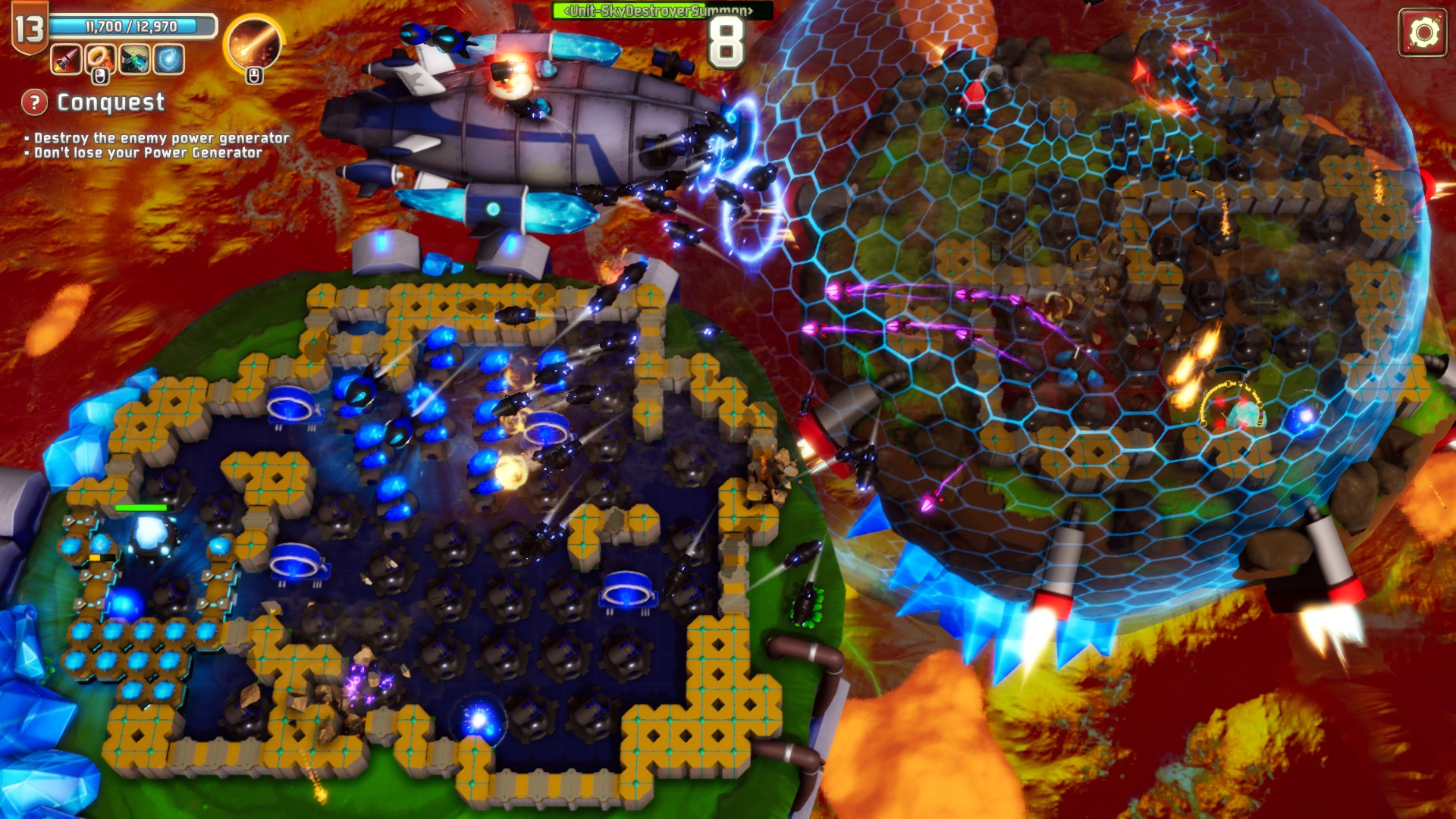
When you get to the later levels, the main way that the AI ups the difficulty seems to just be getting better versions of the upgrades you get. If you get a fire tornado, the opponent gets two fire tornadoes that are twice as large, each. You get a shield that lasts for half a second and has to be precisely timed to have any effect at all, but the opponent gets a super-shield that bounces your own shells back at you that lasts for ten times as long as yours does. Your Tesla shells are worthless, but theirs can halve your offensive abilities.
Basically, the computer is a cheating jerk. (I’d complain more about it, but it still isn’t enough to bring the computer up to a real challenge.)
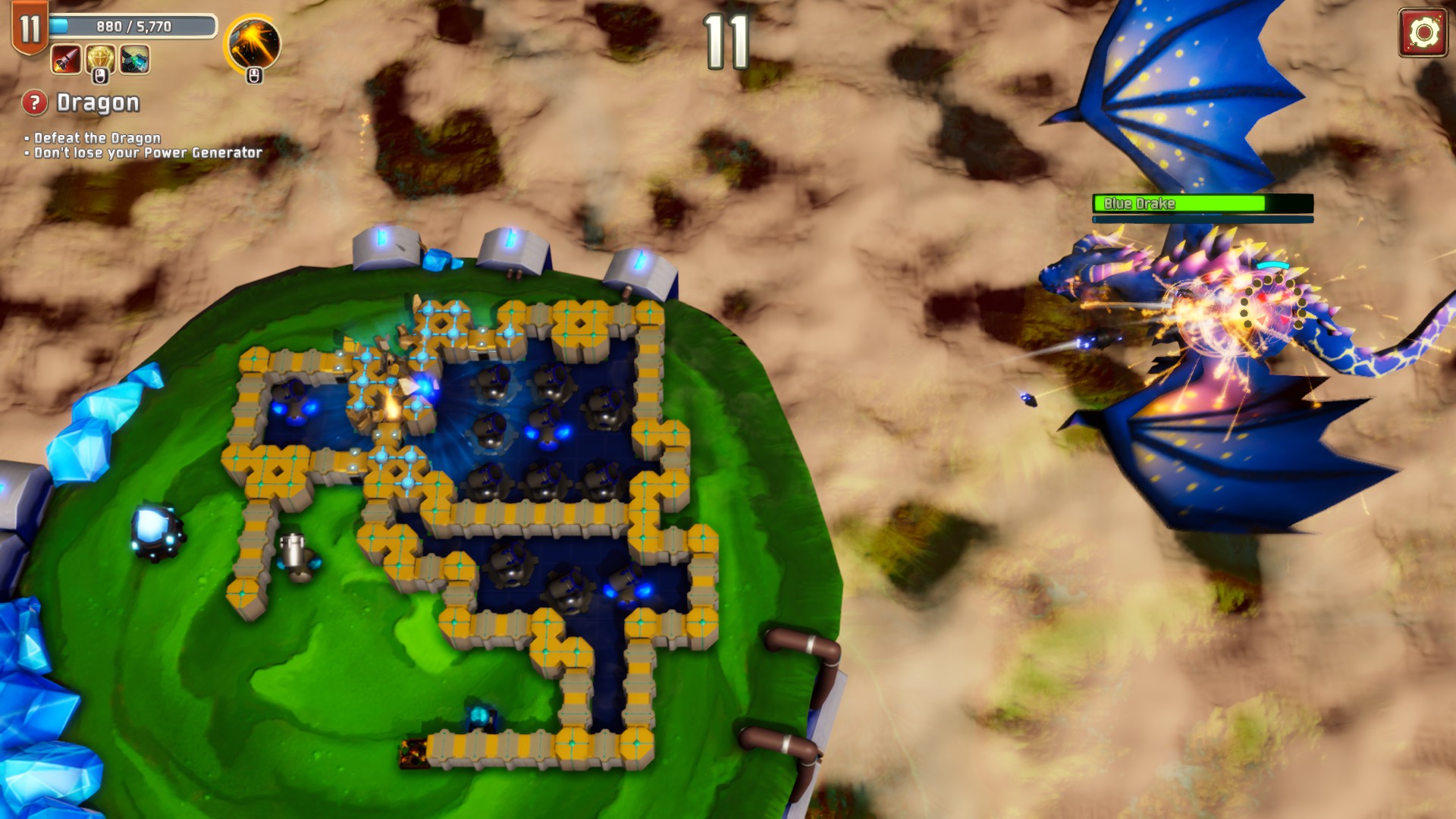
Besides fights against fellow sky islands, you have occasional battles with things that don’t build walls, like dragons or airships. These tend to be much simpler, as you basically just need to keep clicking on the thing until it goes away, although they tend to have some super-power that charges up. The big change-up here is that you have to click something like a flying gem to stop the charge-up before going back to clicking on the dragon. These battles do tend to involve inflicting more damage to you (except the airship one, those go down so quickly, it’s a farce), so there’s some repair phase strategy, but without the indestructible obstacles that Rampart’s sea serpent spat out, dragons are kind of wimps.
The Strategy
Protip: blast diagonal holes in opponent’s walls. One-tile-wide holes are much more difficult to plug because they require the one-tile-wide wall piece to plug them. If the enemy is stupid enough to deliberately make “thick” walls two or three tiles wide (the opponent frequently does this, especially early on), then “checkerboard” holes make it harder for the enemy to plug them. When those walls are sandwiched between places where the opponent cannot build, like cannons and the edge of the island, only a one-by-one wall piece will fit.
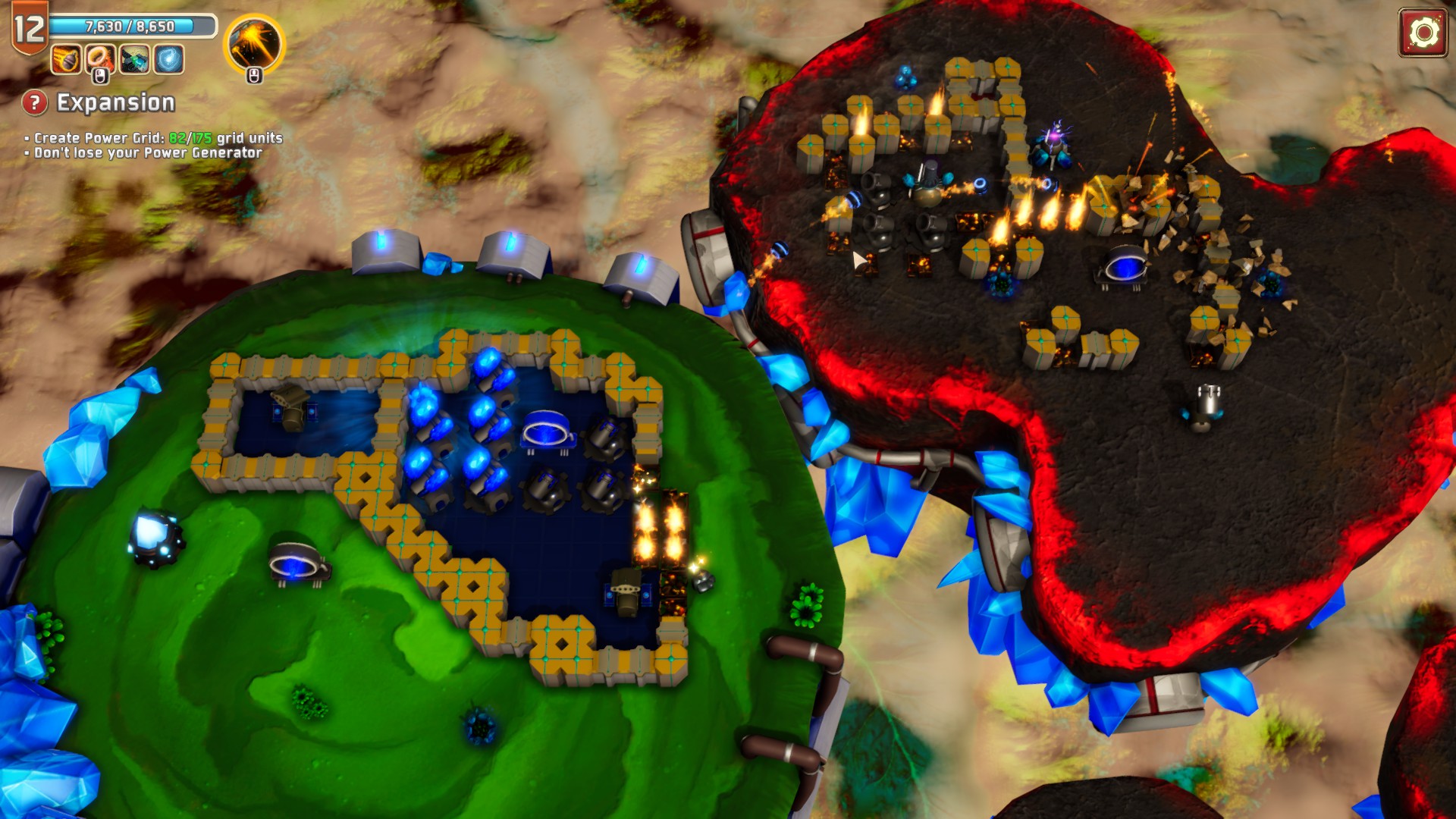
To add to it, always pick fire upgrades when going up against castle-building opponents, as if you set a fire in a hole that can only be filled with a one-by-one wall, then the enemy needs two of those uncommon pieces to fill its gaps per hole you create.
Conversely, the best survival strategy for you is not to build near the edges and have some open corners to dump large pieces near the end of a match. Two upgrades are especially useful for survival – one lets you right-click to change what piece you have, so that you can just right-click until you get one-by-one pieces, while another lets you place walls that overlap. The former is better in a long-term match, while the former is better for rapidly enclosing forts in shorter matches. Since you are only vulnerable in longer matches, however, the Cycle Piece power is ultimately the best.
Hurry Up and Wait
During phases, you typically have 12 to 21 seconds to do whatever the phase is about, but the phase will be cut short if both sides finish early. For example, during the cannon-placing phase, you have 12 seconds, but it’s cut short and immediately goes to the firing phase when both sides have placed all their cannons.
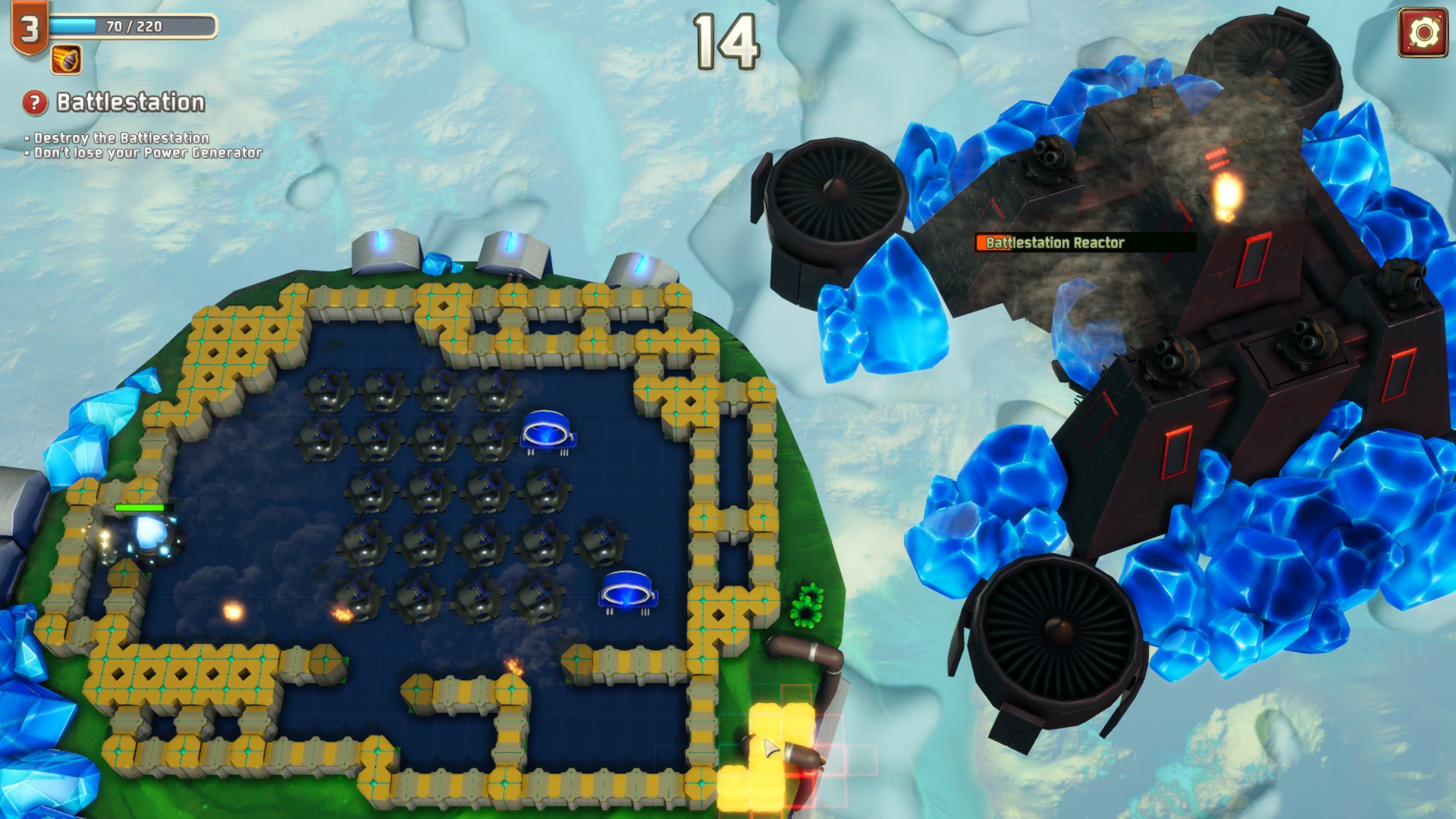
In the version I played, the problem comes when you can’t place all your cannons. The phase did not get cut short when you have no space left to place them all, although when I raised this issue, the developer said he would add a phase-ending button.
However, the same problem exists when you fail to encircle a fort. In the original Rampart, this was a loss condition, so matches were over as soon as you had nothing else to do. In Sky Cannoneers, you basically have to sit still being frustrated while waiting out the cannon placement phase, then the whole firing phase, and if you aren’t dead by then, you can try again… but you’re basically sitting still for at about thirty seconds waiting for the game to let you play it again.
In a game where matches are so short (I can win in two minutes in a fast match, and even long ones go for only about six minutes), having to wait thirty seconds doing absolutely nothing is just frustrating. I really can’t say I appreciate the change from loss on failing to encircle a fort to this generator destruction requirement. At best, it prevents round two knockouts, and that’s just not enough of an advantage to be worth the annoyance of having to wait through pointless rounds or if you really screw up, the formality of having your generator destroyed. (Exiting to the map is at least instantaneous and there are no penalties for doing so.)
Even when you are winning, generators don’t feel like they add much – when it’s too early for you to have enough cannons to take out a generator, it feels like a wasted opportunity, and you might as well not even attack the generator until you have the cannons to take it out in one round (the enemy won’t fire back, after all), and you might as well destroy more walls in the hopes of trying to get another round of no enemy encircled forts soon.
The kicker is that the “Outlast” missions are like the original Rampart in that regard, but they’re just some rare variant mission. The option is there, and they tend to be more fun and snappy, as well as more tense, since you really can’t afford to fail to encircle a fort, but the game is primarily centered around the generators that bog the game down, regardless.
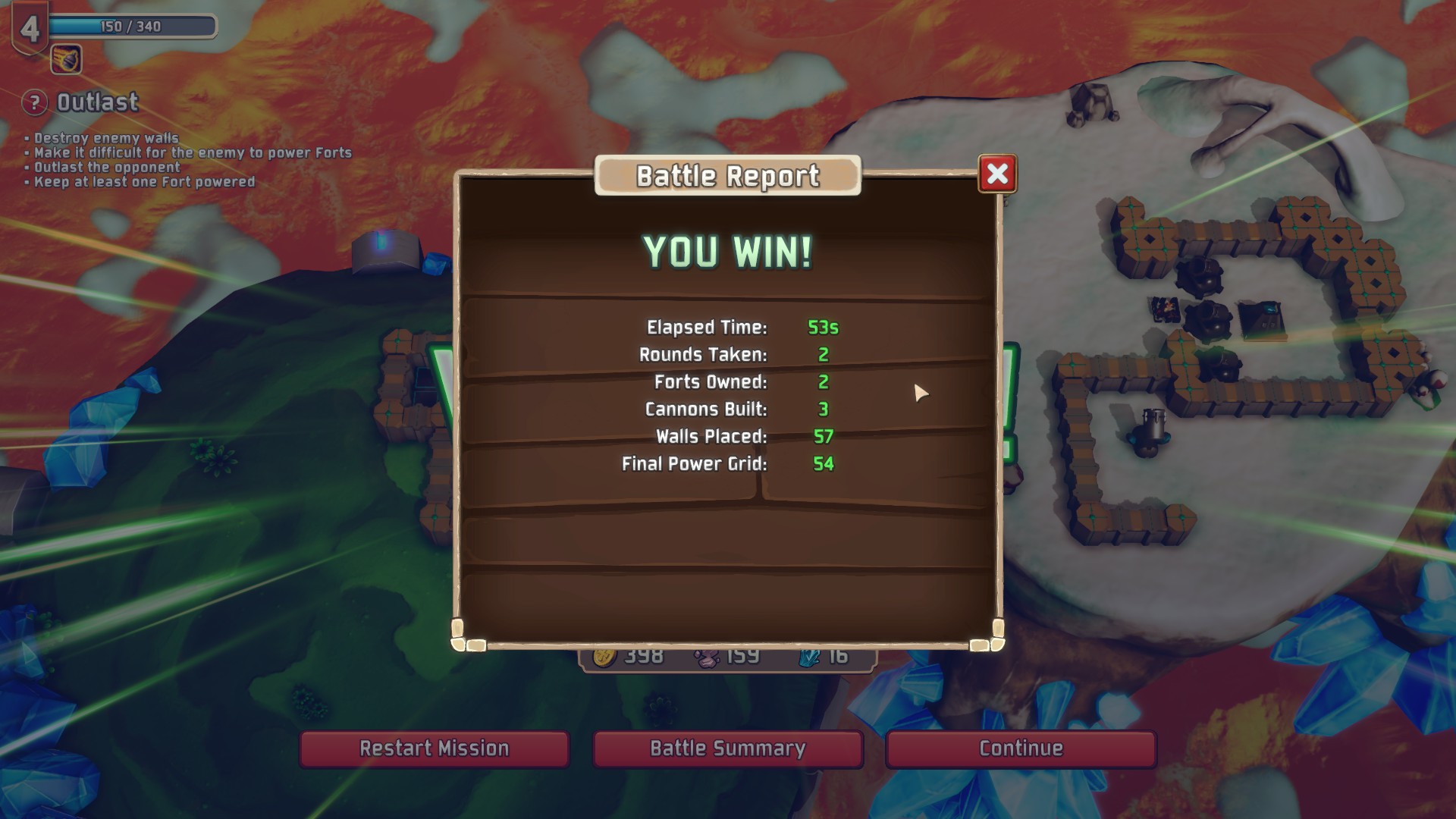
Bugs
I played a beta version before the game came out to send this review out ahead of Sky Cannoneer’s launch. There were a few minor bugs that were tackled by the developer, who was surprisingly fast to respond and quick about putting out patches. The attentiveness of the developer deserves applause, and hopefully, other people’s issues will also be quickly addressed.
That said, I had serious trouble with a bug that caused my computer to freeze at random times while playing the game. The developer apparently could not find a way to reproduce it on any of the test computers, so maybe it’s something limited only to my machine, but it was enough of a problem that it made completing the game a serious problem even before it caused a save corruption that deleted my progress. The game now has a different save system to protect against further corruption, but after having to restart my computer many times and the game from the beginning twice, I wound up not being able to complete the game. The developer tried many things to isolate the bug, but ultimately did not by the time I started writing this review.
Hopefully, this is just my system that has this problem. Maybe a fix will come out an hour after I publish this. However, if there isn’t a fix found, and you do have freezing problems, it may be a fairly pernicious problem, and you may consider refunding if it hasn’t passed 2 hours yet until there’s a fix.
Verdict
It’s… well, it’s Rampart. Remaking a classic game means you basically know what you’re getting, and it’s good, if not really innovating on anything. If the controls demanded a little less precision, it would be a great game for younger players, since the skill ceiling is low and you can especially curb-stomp opponents when you have all the upgrades, but only so far as the early and mid-levels.
One issue I would have is longevity. As it stands, you plow through levels until there are no more levels. No multiplayer means that you basically only play to get all the stars, and few of those are really hard so much as require specific upgrades. I encourage Element Games to get multiplayer into this game, as that was a great source of fun in the original.
This rating, however, is on a game that isn’t a mobile game. Since the waiting bars and potential to just up the amount of coins needed to grind for certain unlocks exist, I have to say that if it had serious grinding elements added to it later along with real-money “time savers” added, the game wouldn’t rate this well.

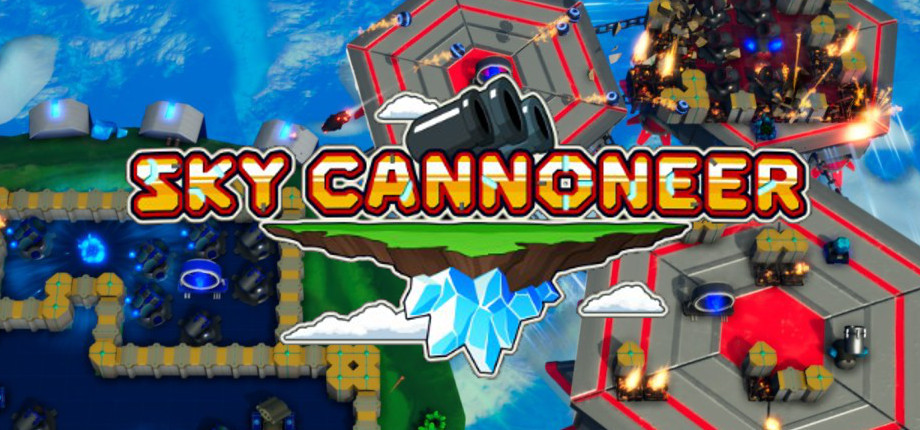









Hi Wraith_Magus, thanks for the review and for rating Sky Cannoneer a Save! Wanted to comment on the computer AI: It doesn’t cheat. The player can also get larger tornados and multiple superpower casts by choosing the correct boosters and forts, at the expense of other upgrades (same tradeoff as the AI). Certainly, there are a few boss fights where the AI has its own specialties though.
Looking ahead, we will adjust the balance and difficulty tuning, incorporating your feedback above and more from other players. Appreciate it!